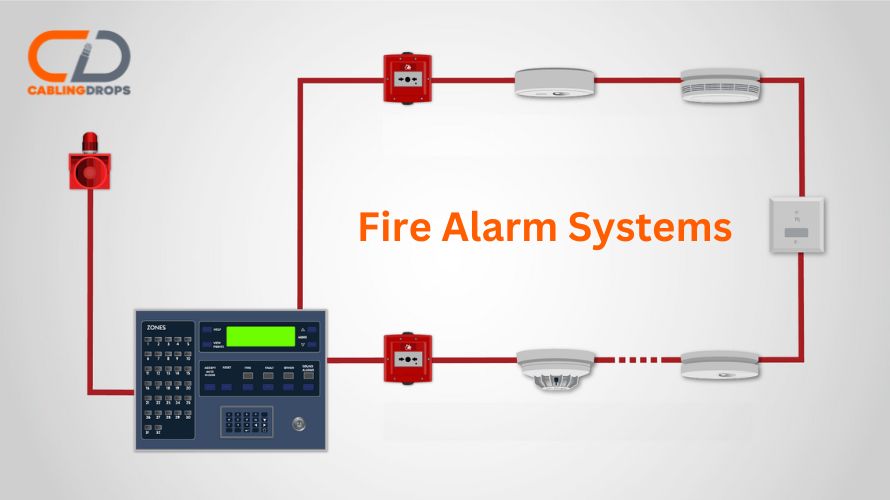
Request A Quote Today!
"*" indicates required fields
Safety is the first priority in any organization, and having a reliable fire alarm system is one of the most critical steps in keeping your workplace safe. Early fire detection and occupant alerting are essential functions of fire alarm systems, which can prevent fatalities and reduce property loss. Everything your company needs to know about fire alarm systems will be covered in this extensive book, including how to select the best system for your building and information on the numerous available types. Whether you want to improve your current system or are considering fire alarm installation, this guide will provide the knowledge you need to make wise choices.
What is a Fire Alarm System?
A fire alarm system is a network of devices working together to detect and alert people of smoke, fire, carbon monoxide, or other fire-related emergencies. These systems are critical for providing early warnings, allowing occupants to evacuate safely and quickly. Home Fire alarm systems are designed to be reliable, providing continuous monitoring and immediate alerts in an emergency.

Components of a Fire Alarm System
A fire alarm system comprises several key components, each vital in the detection and notification. Understanding these components is essential for selecting and maintaining an effective system.
Control Panel
The control panel is the brain of the fire alarm system. It monitors inputs from various detection devices, processes the data, and triggers the alarms if a fire is detected. The control panel also communicates with monitoring stations, ensuring emergency services are promptly notified.
Smoke Detectors
Sensors that identify smoke particles in the air are called smoke detectors. Generally speaking, they fall into three categories: dual-sensor, photoelectric, and ionization. Photoelectric detectors are superior at smoldering fire detection, whereas ionization detectors react faster to blazing fires. Dual-sensor detectors combine the two technologies to provide all-around security.
Heat Detectors
Heat detectors respond to increases in temperature caused by fire. They are typically used in areas where smoke detectors are unsuitable, such as kitchens or garages, where smoke or steam can cause false alarms. Heat detectors come in two main types: fixed temperature and rate-of-rise.
Alarms and Notification Devices
Alarms and notification devices, such as sirens, bells, and strobes, alert occupants of a fire. These devices ensure that everyone in the building knows the emergency, facilitating a quick and orderly evacuation. Modern systems often include voice evacuation systems that provide clear instructions during an emergency.
Monitoring System
The monitoring system ensures that the fire alarm system is constantly supervised. In the event of an alarm, the monitoring system contacts emergency services and provides them with critical information about the location and nature of the fire. This monitoring can be done in-house or outsourced to a professional monitoring service.
Main Types of Commercial Fire Alarm Systems
Understanding the different commercial fire alarm system types is essential for choosing the right one for your building. Each type has its advantages and applications.
Conventional Fire Alarm Systems
Conventional fire alarm systems divide a building into zones, each monitored by a separate circuit. When a detector or alarm within a zone is triggered, the control panel indicates the affected zone but not the specific device. These systems are cost-effective and straightforward but may not provide the pinpoint accuracy needed in more significant buildings.
Addressable Fire Alarm Systems
Addressable fire alarm systems assign a unique address to each device, allowing the control panel to identify the exact location of a triggered alarm. This precision enhances response times and allows for more efficient maintenance and troubleshooting. These systems are ideal for larger or more complex buildings.
Analog Fire Alarm Systems
Analog, or intelligent, fire alarm systems continuously monitor the environment and provide data to the control panel. Instead of simply indicating an alarm, these systems can measure the amount of smoke or heat and provide detailed information about the potential fire. This allows for early detection and minimizes false alarms.
Wireless Fire Alarm Systems
Wireless fire alarm systems use radio frequencies to communicate between devices and the control panel. They are easy to install and ideal for buildings where running wires is impractical or too expensive. Wireless systems also provide flexibility and can be expanded or reconfigured easily.
How to Choose the Right Fire Alarm For Your Building
Choosing the right fire alarm system for your building involves considering several factors, including the size and layout of the building, the nature of its occupancy, and your specific fire safety needs. Here are some key points to consider:
Building Size and Layout: Addressable or analog systems for precise detection and monitoring may benefit larger buildings with complex layouts.
Occupancy Type: Different types of businesses have different fire safety requirements. For example, a warehouse will have different needs than an office building.
Regulatory Requirements: Ensure your chosen system complies with local fire codes and regulations.
Scalability: Consider whether the system can be easily expanded or upgraded as your business grows.
Integration: Look for a system that can integrate with other safety and building management systems for comprehensive protection.
Integration of Fire Alarm System with Other Technologies
Integrating your fire alarm system with other building technologies can enhance safety and efficiency. Modern fire alarm systems can be connected to building automation, security, and emergency communication systems. This integration allows for coordinated responses to emergencies, automated safety protocols, and centralized control and monitoring.
For example, integrating a fire alarm system with a building’s HVAC system can help control smoke spread by shutting down ventilation in affected areas. Integration with security systems can ensure that emergency exits are unlocked during a fire, facilitating safe evacuation.
Commercial Fire Alarm System at Cabling Drops
Upgrade your commercial fire detection system with Cabling Drops, which offers dependable, cutting-edge fire alarm systems customized to meet your requirements. Our knowledgeable staff guarantees strong performance and smooth integration, providing you with peace of mind and adherence to safety requirements. Don’t gamble with your safety. For a consultation and to take your fire protection to the next level, contact Cabling Drops immediately. Don’t wait to protect your company!
Frequently Asked Questions
What three things must a fire detection system do?
Detect the Fire: The system must accurately detect the presence of a fire through smoke, heat, or flame detectors.
Alert Occupants: It must effectively notify building occupants through alarms, sirens, and notification devices.
Notify Emergency Services: The system should automatically contact emergency services to ensure a rapid response.
What should I look for in a fire alarm system?
When selecting a fire alarm system, consider:
Compliance: Ensure the system meets local fire codes and regulations.
Reliability: Choose a system known for its reliability and low false alarm rate.
Scalability: The system should be able to grow with your business.
Integration: Look for systems integrating with other building safety and management technologies.
Support: Consider the availability of technical support and maintenance services.
What is the most essential part of a fire alarm system?
The control panel is the most essential part of a fire alarm system. It acts as the central hub, monitoring all inputs from detectors and controlling outputs to alarms and notification devices. Without a functioning control panel, the system cannot detect, alert, or communicate effectively during a fire emergency.
What is the need for a fire alarm system?
A fire alarm system is needed to:
Ensure Safety: Protect occupants by providing early warnings of fire.
Minimize Damage: Early detection helps to control the spread of fire, reducing property damage.
Compliance: Meet legal and regulatory requirements for fire safety.
Peace of Mind: Provide confidence that the building is protected and that occupants are safe.
How to operate a fire alarm system?
Operating a fire alarm system involves:
Regular Testing: Periodically test the system to ensure all components work correctly.
Maintenance: Conduct regular maintenance to keep the system in good condition.
Training: Train staff to respond to alarms and use the system’s features, such as manual pull stations and voice evacuation systems.
Monitoring: Ensure the system is continuously monitored in-house or through a professional service.